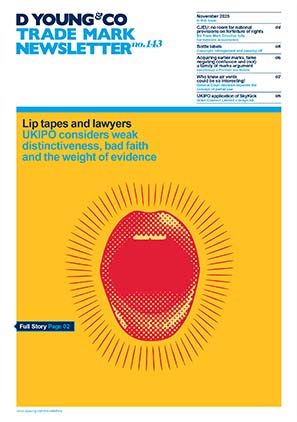Weak distinctive character comes NATURA-lly
This case demonstrates the limitations associated with enforcing a trade mark containing descriptive components.
Eugène Perma France sought to register an EU trade mark for NATURANOVE. The application was opposed by SPI Investments Group on the basis of its prior rights in the mark NATURALIUM (including an international registration designating the EU and a Spanish national trade mark).
Both NATURANOVE and NATURALIUM cover identical goods in class 3, including cosmetics and hair products.
First instance and Board of Appeal
The opposition was successful at first instance, on the grounds of a likelihood of confusion under Article 8(1)(b) EUTMR. The Board of Appeal then dismissed the applicant’s appeal. In particular, when assessing the case, the Board of Appeal held that:
- The level of attention of the relevant public at large in the EU was generally average, and could even sometimes be higher for goods applied to the skin;
- The signs are visually and phonetically similar to an average degree and, as a whole, conceptually have no meaning (although each share the notion behind “natura”);
- Overall, the earlier mark NATURALIUM has a normal degree of distinctiveness;
- The common element “NATURA-“ evokes an association with the word “nature” and has a weak distinctive character relative to the goods;
- The goods are identical; and
- Overall there was a likelihood of confusion. That the component “natura” was allusive did not change this finding, even for the attentive public.
Appeal to General Court
Eugene Perma France appealed again to the General Court, claiming that the Board of Appeal had erred in its assessment of the similarity of marks; the distinctive character of NATURALIUM; and the overall analysis of the likelihood of confusion.
In its appeal, the applicant claimed that the marks were not similar. In particular, the applicant submitted that regardless of the placement of the common element “NATURA” as the prefix of both marks, the component was limited or non-existent in its distinctiveness, whilst the elements “-NOVE” and “-LIUM” were completely different.
In contrast, the EUIPO claimed that the element “NATURA” was not directly descriptive and that its placement at the beginning of both trade marks compensated for the low distinctive character within the overall framework of a likelihood of confusion.
In its decision, the General Court held that the similarities between the signs were visually and phonetically limited to the first component, “NATURA”, and that this common prefix was weakly distinctive, whilst the endings “-LIUM” and “-NOVE” were completely different. These differences played an important role and the trade marks NATURANOVE and NATURALIUM were considered by the General Court to be visually and phonetically similar to only a low degree, rather than an average degree as the Board of Appeal had previously held. In addition, taking into account the weak distinctive character of the common component “NATURA”, the General Court found the conceptual similarity between the signs to be low.
In terms of the inherent distinctive character of the earlier mark, NATURALIUM, the General Court noted that the mark comprises only two elements, of which one element “NATURA” would be perceived as alluding to the natural origin of the Class 3 goods and was weakly distinctive, whilst “LIUM” is shorter and would not strengthen the overall distinctiveness of the earlier mark. The General Court therefore agreed with the applicant that the earlier mark had a weak distinctive character, rather than a normal level of distinctive character as had been held by the Board of Appeal.
Therefore, the General Court concluded that the different suffixes of the marks compensated for the common prefix “NATURA” and, notwithstanding the identity of goods, there would be no likelihood of confusion. The Board of Appeal’s decision was therefore annulled.
During its overall assessment of a likelihood of confusion, the General Court remarked that: “a company that chooses a trade mark with a low degree of distinctiveness must accept that competitors are equally entitled to use trade marks with similar or identical descriptive components.”

